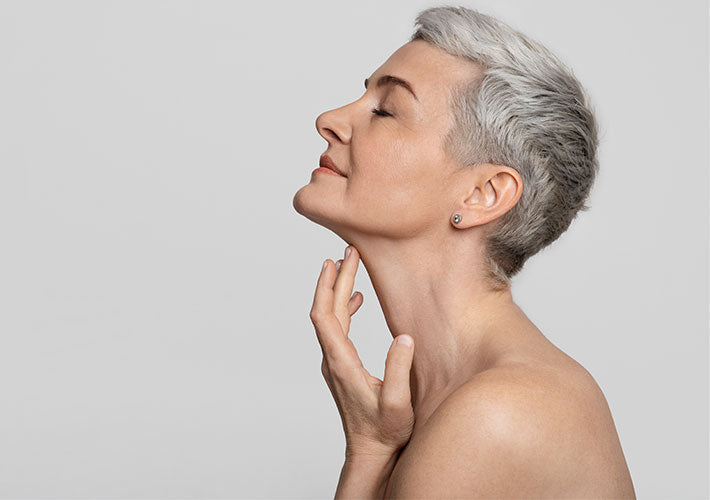
External Effects on Aging
Posted by Terri Wojak on
Aging is both inevitable and continuous, making it one of the leading concerns for clients. Today people are more concerned with healthy aging and prevention than trying to repair damage after the fact. With that focus in mind, it is vital that we keep our clients properly educated. Although some aspects of aging are out of our control, it is important to put an emphasis on what we can control.
There are two primary factors that cause aging: intrinsic and extrinsic. Intrinsic aging is how the skin changes over time, regardless of environmental factors. Genetics play a large role in this process and those cannot be altered. Genetics can be related to the loss of subcutaneous fat and the reduction of collagen and elastin. Physiology is also a part of the intrinsic aging process. This can be related to expression lines from smiling and loss of elasticity from gravity. If intrinsic aging were to occur without exposure to external elements, the skin would still lose volume due to the reduction in subcutaneous fat. Loss of structure from collagen and elastin and the effects of gravity would result in loose or sagging skin. Fine lines and wrinkles would appear in areas of facial expression. However, the skin would remain smooth without keratosis, pigmented lesions, hypopigmentation, telangiectasia, and damaged collagen and elastin leading to deeper, more pronounced wrinkles.
Approximately 85% of the changes we see in our skin come from external factors or extrinsic aging. Sun exposure, smoking, lifestyle, pollution, and diet are all factors that are enough to make a significant difference in whether a person will have the same skin conditions as another member of their family or not. Knowing the factors associated with aging skin and the damaging effects they produce is essential in learning to prevent it.
UV Exposure
Ultraviolet radiation from direct sunlight, is the most prevalent extrinsic factor. When UV light reaches the skin, some is reflected by skin cells and oil. Light that is not reflected enters the epidermis, where some of it is absorbed by melanin. Fitzpatrick skin types I–III have little absorption due to the low amount of melanin present, while types IV–VI will absorb more UV. UV that is not absorbed may affect protein, DNA, and other structures of the epidermis. UV also creates damage to Langerhans cells, which greatly affects the immune system and can lead to skin cancer. UV rays that enter the dermis can damage collagen, elastin, and glycosaminoglycans (GAGs), leading to accelerated skin damage.
Smoking
Smoking replaces oxygen with carbon monoxide which decreases the amount of oxygen available for the body to function properly. Cigarette smoke is not only a mixture of chemicals with carcinogenic and toxic potential, but also contains stable free radicals, reactive oxygen species (ROS), and gaseous free radical species.1 This leads to asphyxiation, a slowdown of cell turnover, and reduced circulation which result in a dry, dull, gray appearance. Cigarette smoke also triggers the production of matrix metalloproteinases (MMPs), which are enzymes responsible for the breakdown of collagen and elastin.
Diet
It is now known that diet can affect the appearance of the skin. It only makes sense that the largest organ of the body would show what is happening inside. Those with diets high in fat, sugar, and complex carbohydrates experience increased blood sugar levels rapidly after each meal. This provides a short energy boost but soon follows with a fall in blood sugar levels. This rapid drop results in fatigue and hunger. This vicious cycle is unhealthy and leads to long-term inflammation and cell injury. Excess sugar also affects collagen fibers though a process called glycation, which causes the skin to appear yellow and look older.2 Excessive alcohol consumption can also trigger this process and lead to dehydration and slowed cellular turnover.
Stress
Stress is another factor that can affect the skin. Cortisol, known as the stress hormone which produces the flight or fight response, is beneficial in small amounts. Increased cortisol levels for extended periods of time can lead to many problems including glycation which is responsible for a breakdown of collagen and elastin. Compromised immunity and impaired barrier function can leave the skin open to external invaders and transepidermal water loss. Additionally, a decrease in blood flow and cell turnover can result in a dull, tired appearance. Sleep deprivation is also associated with these conditions, as it raises stress levels in the body.
To a certain extent, we can manage some extrinsic factors of aging skin. UV exposure being the most prevalent and dangerous, can be prevented with antioxidants, sunscreen, and avoiding prolonged sun exposure. When it comes to smoking, the answer is simple, quit or don’t start. This will allow proper circulation and oxygenation for healthy skin. Diet management isn’t quite as simple. The abundance of inexpensive, unhealthy food can be an obstacle for consumers when trying to make healthier choices. Following a nutrient-filled diet is essential for a healthy body and skin. Stress is going to be the hardest to manage. With the current climate, most people are experiencing heightened levels of stress. Advising clients to explore exercise, yoga, or meditation can result in a reduced stress level, as well as healthier looking skin. Topical products are an essential aid when managing extrinsic aging. An emphasis on ingredients including retinoids, antioxidants, peptides, and sunscreens will result in the optimal health of the skin. Remember, the skin can be a direct reflection of how we care for our bodies.
References
- A Valavanidis et al, Tobacco smoke: Involvement of reactive oxygen species and stable free radicals in mechanisms of oxidative damage, carcinogenesis and synergistic effects with other respirable particles, Intl J Environ Res Public Health, 6 (2), 445–462 (2009). 2. P Gkogkolou and M Böhm, Advanced glycation end products: Key players in skin aging? Dermatoendocrinol, 4 (3), 259-270 (2012)
